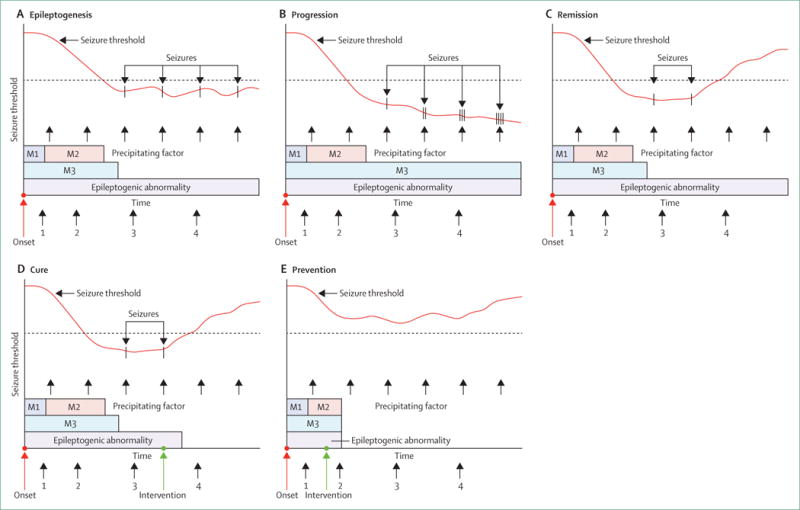Figure 2. Epilepsy biomarkers.

The bars at the bottom of each panel indicate epileptogenic mechanisms (M1, M2, and M3) involved in the development of an epilepsy condition. Some of these processes are time-limited and others can continue as the enduring epileptogenic abnormality responsible for the propensity to generate spontaneous seizures, in response to precipitating factors that might or might not be easily identified. The red line represents the seizure threshold, which decreases during epileptogenesis to a point at which spontaneous seizures can occur. Epileptogenesis (A). The cascade of epileptogenic mechanisms can be measured at points 1 and 2. These points and might enable staging of the epileptogenic process. The existence of an enduring epileptogenic abnormality can be measured at points 3 and 4, and other measures at these timepoints could indicate that the seizure threshold is at a level where spontaneous seizures can occur. Progression (B). The cascade of epileptogenic abnormalities at points 1 and 2 would be similar to that in part A, but measures at points 3 and 4 would show that a more pronounced epileptogenic abnormality persists. These timepoints would also indicate that the threshold continues to decrease, causing seizures to be more frequent and more severe. Remission (C). Following an intervention after point 3, a measurement at point 4 would show that the threshold is raised above the level at which spontaneous seizures occur; however, the epileptogenic abnormality persists. This persistence is in contradistinction to cure (D). In this case, a measurement taken at point 4 would show that the return of threshold to a normal level is due to the fact that the epileptogenic abnormality has gone. Prevention (E), in which an intervention between points 1 and 2 results in a complete elimination of the epileptogenic process. Measurements at points 3 and 4 would then show that the threshold never dips below a level at which spontaneous seizures would occur, and that an epileptogenic abnormality never developed. Reproduced from Engel and colleagues,23 by permission of John Wiley and Sons.
